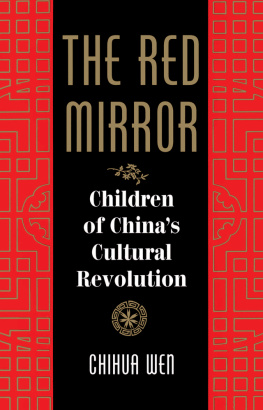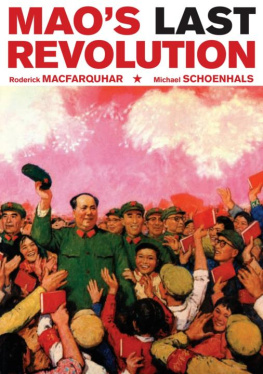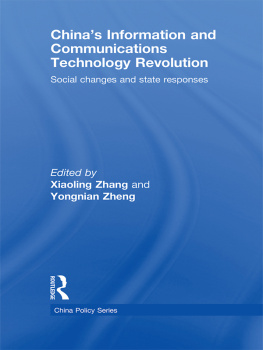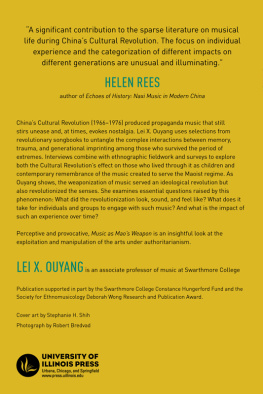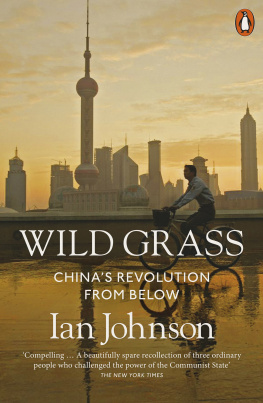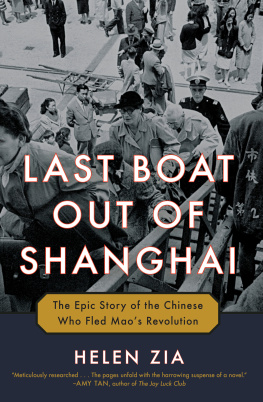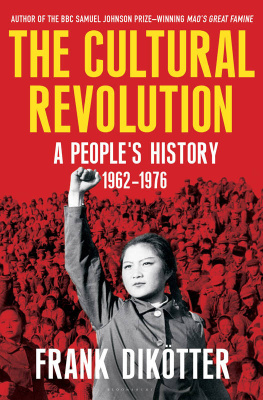The Red Mirror
The Red Mirror
Children of China's Cultural Revolution
Chihua Wen
edited by Bruce Jones
with a foreword by Richard P . Madsen
First published 1995 by Westview Press
Published 2018 by Routledge
711 Third Avenue, New York, NY 10017, USA
2 Park Square, Milton Park, Abingdon, Oxon OX14 4RN
Routledge is an imprint of the Taylor & Francis Group, an informa business
Copyright 1995 by Chihua Wen and Bruce Jones
All rights reserved. No part of this book may be reprinted or reproduced or utilised in any form or by any electronic, mechanical, or other means, now known or hereafter invented, including photocopying and recording, or in any information storage or retrieval system, without permission in writing from the publishers.
Notice:
Product or corporate names may be trademarks or registered trademarks, and are used only for identification and explanation without intent to infringe.
Library of Congress Cataloging-in-Publication Data
Wen, Chihua.
The red mirror : children of China's Cultural Revolution / Chihua Wen; edited by Bruce Jones with a foreword by Richard P. Madsen.
p. cm.
ISBN 0-8133-2489-0 ISBN 0-8133-2488-2 (pbk.)
1. ChinaHistoryCultural Revolution, 1966-1969Personal narratives. I. Jones, Bruce. II. Title.
DS778.7.W45 1995
951.05'6DC20
94-29828
CIP
ISBN 13: 978-0-8133-2488-3 (pbk)
Dedicated to my mother and my father,
who tried very hard to keep the evils of my own society
far from my brother and me even while they were consigned
to purgatory by the Party they thought they were serving
Ancient mirrors are supposed to have magic power to protect their owners from evil. They are believed to make hidden spirits visible and reveal the secrets of futurity.
Ch'in Shih Huang, the first Emperor of the Chin dynasty, a.d. 255 , was credited with the possession of a magic mirror, which had the power of reflecting the inward parts of those who looked upon it.
Li Shih-min, a.d. 597 649, the second Emperor of the T'ang dynasty, is recorded to have remarked, "By using a mirror of brass you may see to adjust your cap; by using antiquity as a mirror, you may learn to foresee the rise and fall of Empires."
Encyclopedia of Chinese Symbolism and Art Motives
Contents
, RICHARD P. MADSEN
RICHARD P. MADSEN
More important for the destiny of a society than the machinations of its politicians, the power of its armies, or the size of its police forces is the climate of opinion that sustains its common hopes. For instance, as Franz Schurmann put it, "the Soviet colossus was brought down not by foreign defeat, revolution in the streets, or fatal factional disputes but by a profound loss of spiritual faith. Ironically for a system that prided itself on atheism and materialism, it turned out to be critically dependent on this faith. Communism was a kind of religion, and when people stopped believing in it, they withdrew their support and the colossus fell. But how does a whole society lose its faith? Surely changes in a collective consciousness are the aggregation of millions of small breaking points, moments in time when individual men and women realize that they can no longer believe, that their old notions of what was good and effective no longer make sense.
Often, we can trace these small breaking points to some great collectively experienced trauma. China's Cultural Revolution was certainly such a collective trauma, leading eventually to a national loss of faith in communist ideology. After the Cultural Revolution, even though the Chinese Communist Party (CCP) continued to govern China, it could no longer plausibly claim to represent a historical vanguard; to stay in power, it had to adopt economic policies that contradicted its basic principles. But how do great collective traumas like the Cultural Revolution actually cause the individual breaking points in belief that together lead to a fundamental shift in national consciousness?
This collection of poignant stories is about a handful of such breaking points, episodes when Chinese individuals at a formative time in their lives severed the crucial strand of connection with the fabric of beliefs that connected them to the Chinese communist ideological system. Although each breaking point is different, they have important common features.
In each case, the crucial link is not a thick rope of ideas connecting the mind to the state but a delicate filament connecting the heart to a member of the family. Each of the individuals who tell their stories here was only a child or adolescent at the time of the Cultural Revolution. They remember believing at first that they would be properly connected to their Chinese "motherland" by being properly connected to their mothers and fathers. In each case, this belief was put to the test. Parents were condemned as "rightists," "capitalist readers," or "counterrevolutionaries." Children had to decide whether to side with forces representing the motherland or with their real mothers and fathers. Sometimes the children participated in denunciation; other times they did what they could to shield their parents. If they did participate in harming their parents, they carried a burden of guilt that debilitated their connections to the larger social system. If they helped their parents, they harbored a bitter core of cherished defiance that they called on sometimes to resist too close a commitment to their would-be leaders.
In each case, the decisive event, the thing that became the focal point of their stories twenty years later, was not necessarily something of extraordinary material or practical importance, but something of great symbolic significance. A girl killed her pet hen to make chicken soup for her imprisoned father. Another girl made her grandmother destroy a cherished family heirloom. A boy melted down the incense burner his mother used to worship the Buddha. These violations of the idiosyncratic symbolic economy of a family's loyalties, mutual responsibility, and affection became the defining moments after which the moral bonds most intimately connected with a persons identity were never the same again.
"The Cultural Revolution", said the Maoists, "is a great revolution that touches men's very souls." In these stories, the events that most profoundly touched souls and in the end had the greatest influence on history were not the public "great" eventsthe purges of top Party officials, the mobilization of the Red Guards, battles between Red Guard factions, the downfall of Lin Biaobut domestic "great" events played out in the homely details of household life. However, to fully appreciate the lessons that these stories hold about the importance of this reduction of great events to domestic scale, we need to read the stories with some awareness of the great events occurring in the background.
The Cultural Revolution began in late 1965 with Mao Zedong's attempts to topple high-level Party members who were surreptitiously criticizing him through publication of literary works (including the series of stories about the Three Family Village in the Beijing Evening News mentioned in the Author's Introduction). In the early part of 1966, however, crucially placed officials managed to contain the criticism to a few allegedly disloyal writers and artists without implicating the high Party officials who supported the ideas expressed in the literary works. Mao took this as an indication that important leaders in the Party were arrayed against him. He and his associates came to believe that the Party was thoroughly infiltrated with people who, even though they might have been lifelong communists, had given up the ideals of true communism and "followed the capitalist road."

